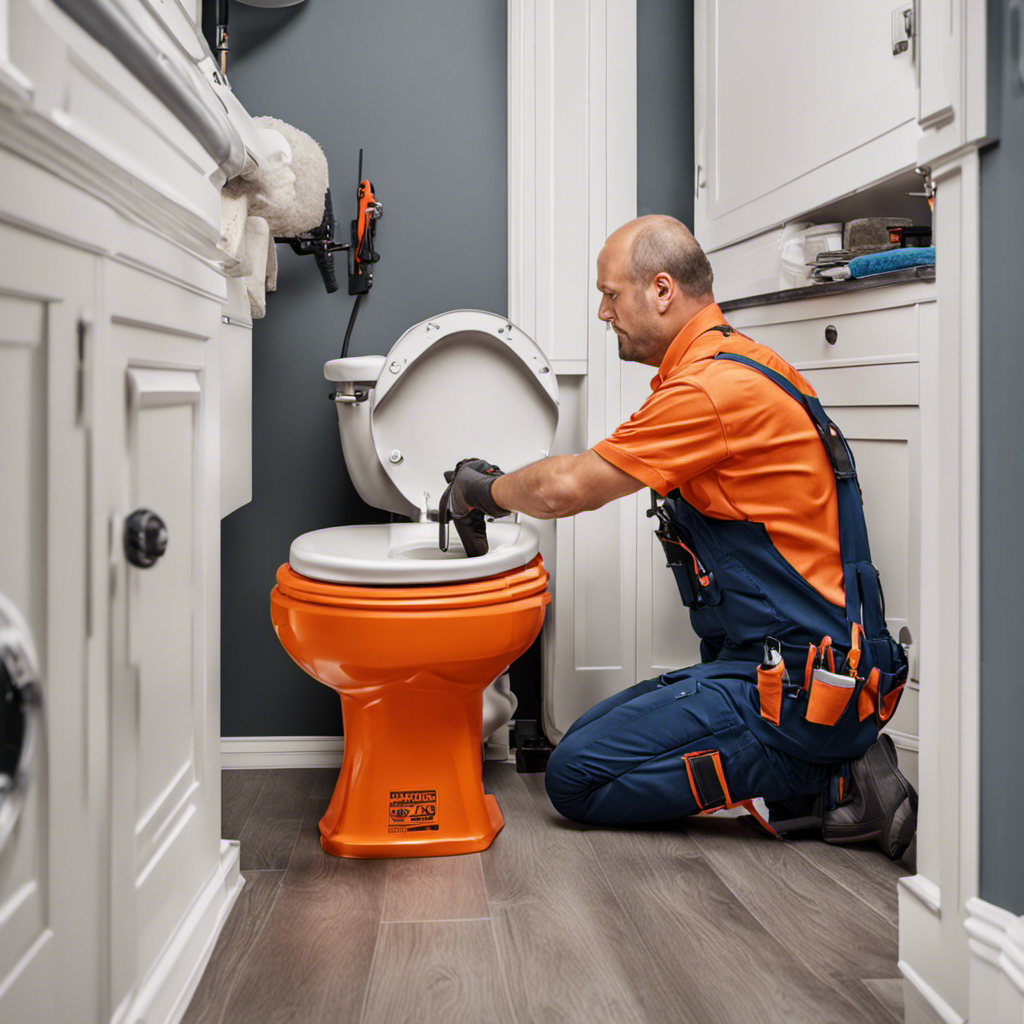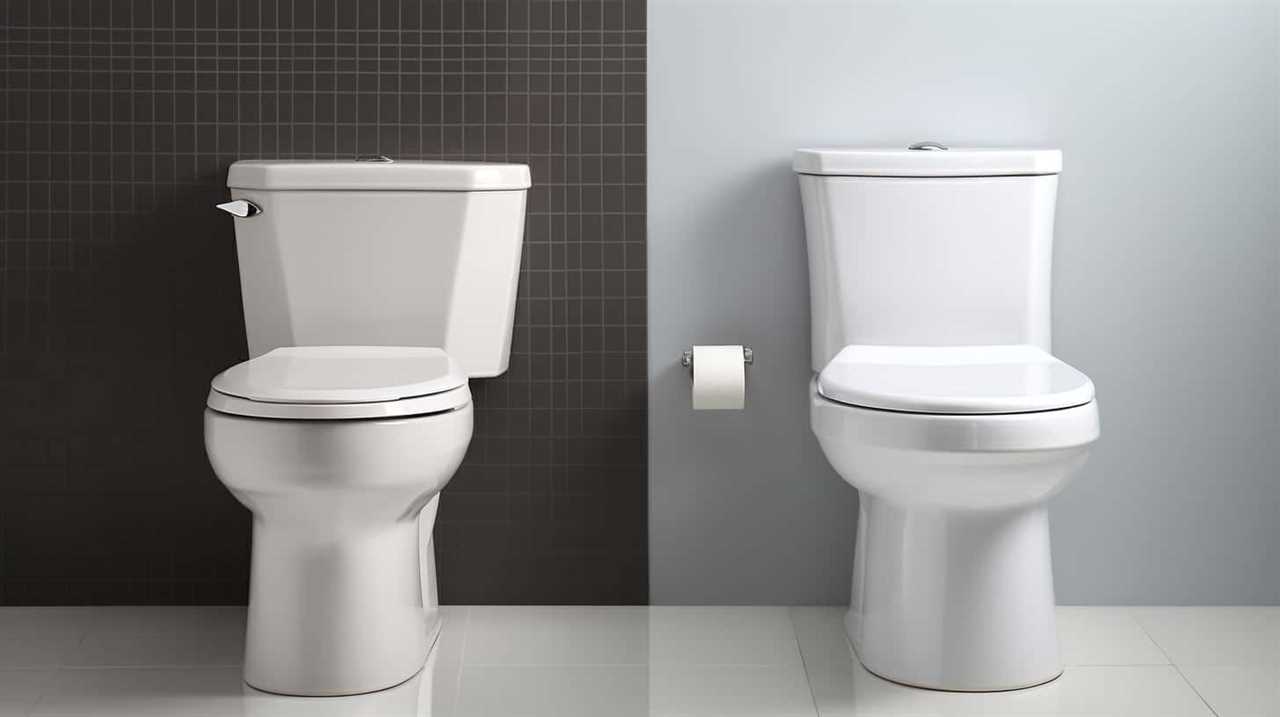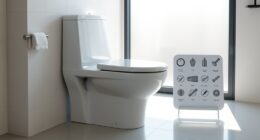Is investing in intelligent toilets a smart financial decision?
We’ve all been there – the groggy mornings when we stumble into the bathroom, half awake, only to be greeted by a freezing cold toilet seat. But what if your toilet could be warm and welcoming, ready to embrace you with its smart technology?
In this article, we’ll dive into the pros and cons of investing in a smart toilet, from cost and convenience to environmental impact and potential plumbing issues.
So, let’s plunge into the world of smart toilets and explore if they truly are worth the investment.

Key Takeaways
- Smart toilets may have a higher price tag compared to traditional toilets, but conducting a cost benefit analysis is crucial to determine their worth.
- Smart toilets contribute to water conservation and energy savings, leading to long-term cost savings on utility bills.
- Smart toilets offer enhanced comfort and convenience with features like heated seats, adjustable water temperature, and automatic lid opening and closing mechanisms.
- Smart toilets provide hygiene and health benefits through automatic flushing, self-cleaning functions, and integrated bidet functions, minimizing the risk of bacterial contamination and promoting better personal hygiene.
Cost of Installation and Maintenance
One major factor to consider when determining the worth of smart toilets is the cost of installation and maintenance. Conducting a cost benefit analysis is crucial to understand if the investment is worthwhile.
While smart toilets offer a range of advanced features and technologies, they also come with a higher price tag compared to traditional toilets. The installation challenges associated with smart toilets can also affect the overall cost. These toilets often require professional installation due to their complex design and plumbing requirements.
Additionally, maintenance costs should be taken into account, as the sophisticated components of smart toilets may require specialized repairs. It’s important to weigh these factors against the potential benefits and convenience that smart toilets can provide in order to make an informed decision about their worth.
Energy Efficiency and Cost Savings
When considering the worth of smart toilets, it’s important to evaluate their energy efficiency and potential for cost savings. Here are four key points to consider:

- Cost effectiveness: While smart toilets may have a higher upfront cost compared to traditional toilets, their energy-saving features can lead to long-term savings on utility bills.
- Return on investment: Investing in a smart toilet can provide a significant return on investment over time. The energy-efficient benefits of these toilets can help offset the initial cost and contribute to cost savings in the long run.
- Long-term savings: Smart toilets are designed to minimize water usage through features like dual-flush options and sensor-based flushing. This can result in reduced water consumption, leading to lower water bills and long-term cost savings.
- Energy efficient benefits: In addition to water savings, smart toilets often come equipped with features such as automatic lid opening and closing, heated seats, and energy-saving modes. These features not only enhance comfort and convenience but also contribute to energy efficiency and cost savings.
Considering the energy efficiency and potential for cost savings, smart toilets prove to be a worthy investment.
Now let’s explore how they enhance comfort and convenience.
Enhanced Comfort and Convenience
Let’s explore how smart toilets enhance our comfort and convenience.
Smart toilets are designed with features that prioritize our relaxation and accessibility. These advanced toilets often come equipped with heated seats, allowing us to experience enhanced relaxation during our bathroom breaks. Imagine the comfort of sitting on a warm seat during cold winter mornings!

Additionally, smart toilets offer adjustable water temperature, pressure, and even spray patterns, providing a personalized and luxurious cleansing experience.
As for improved accessibility, these toilets often feature automatic lid opening and closing mechanisms, eliminating the need for manual handling and reducing the risk of germs spreading. Some models even offer voice control and touchless flushing, making it easier for people with mobility issues to use the toilet independently.
With smart toilets, comfort and convenience are taken to a whole new level.
Hygiene and Health Benefits
When it comes to hygiene and health benefits, smart toilets offer improved cleanliness standards that can have a positive impact on our overall well-being.

With features like automatic flushing and self-cleaning functions, these toilets minimize the risk of bacterial contamination and help maintain a higher level of sanitation.
Additionally, some smart toilets incorporate advanced features like bidet functionality, which can provide potential health advantages by promoting better personal hygiene and reducing the use of toilet paper.
Improved Cleanliness Standards
Maintaining improved cleanliness standards is essential for ensuring optimal hygiene and reaping the health benefits of smart toilets. With their advanced features and technology, smart toilets have revolutionized the way we approach sanitation and germ control. Here are four reasons why smart toilets are worth the investment:
- Self-cleaning capabilities: Smart toilets are equipped with self-cleaning functions that eliminate the need for manual scrubbing, reducing the spread of germs and bacteria.
- Antibacterial surfaces: Many smart toilets come with antibacterial coatings that inhibit the growth of harmful microorganisms, further enhancing cleanliness and reducing the risk of infections.
- Automatic flushing and lid closing: These features minimize human contact with the toilet, preventing the transfer of germs and ensuring a more hygienic experience.
- Integrated bidet functions: Smart toilets often include bidet features, which provide a thorough and gentle cleaning experience, promoting better personal hygiene.
Potential Health Advantages
With the potential health advantages that come with improved hygiene and health benefits, smart toilets are definitely worth considering as an investment.

These innovative fixtures offer a range of features that can help enhance personal cleanliness and reduce potential health risks.
For instance, some smart toilets are equipped with bidet functionalities, which not only provide a more thorough cleaning experience but also reduce the need for toilet paper, minimizing the risk of spreading germs.
Additionally, smart toilets often include self-cleaning options, ensuring a hygienic environment for every user.
Furthermore, these toilets can track and analyze data related to users’ bathroom habits, offering insights into potential health issues. This valuable information can be shared with healthcare professionals, leading to better diagnoses and personalized care.

Environmental Impact and Sustainability
When considering the environmental impact and sustainability of smart toilets, there are several key points to consider.
Firstly, these toilets often come equipped with water conservation methods, such as dual-flush options or low-flow technology, which can significantly reduce water usage.
Secondly, many smart toilets are designed with energy-efficient features, such as motion sensors or LED lighting, helping to minimize electricity consumption.
Lastly, the reduction of waste is another important aspect, as smart toilets often incorporate features like self-cleaning capabilities or bidet functions, which can reduce the need for toilet paper.

Water Conservation Methods
To achieve environmental impact and sustainability, we can employ various water conservation methods. Here are four water-saving technologies that can help us reduce our water consumption:
- Smart Toilet Features: Smart toilets come equipped with advanced features such as dual-flush options, which allow users to choose between a full flush for solid waste and a reduced flush for liquid waste. This helps conserve water by using only the necessary amount for each type of waste.
- Low-Flow Fixtures: Installing low-flow fixtures, such as faucets, showerheads, and toilets, can significantly reduce water usage. These fixtures are designed to restrict the flow of water without compromising performance or user experience.
- Rainwater Harvesting: Collecting rainwater for non-potable uses like gardening and toilet flushing can help reduce reliance on freshwater sources. This method not only conserves water but also reduces the strain on municipal water supplies.
- Greywater Systems: Greywater refers to wastewater from sources like sinks, showers, and washing machines. By treating and reusing greywater for purposes like irrigation, we can reduce the amount of freshwater required for outdoor use.
Energy-Efficient Features
To enhance environmental impact and sustainability, we can explore the energy-efficient features of smart toilets. These innovative toilets are designed to minimize energy consumption and reduce the environmental footprint of our daily bathroom routines. One of the key features of energy-efficient toilets is their ability to save water through advanced technology. By incorporating water-saving mechanisms such as dual-flush systems and low-flow options, these toilets significantly reduce water usage without compromising on performance.
To further emphasize the benefits of energy-efficient toilets, let’s take a look at the table below:
| Energy-Efficient Features | Benefits |
|---|---|
| Dual-flush system | Reduces water consumption by allowing users to choose between a partial or full flush. |
| Low-flow technology | Minimizes water usage without sacrificing flushing power. |
| Sensor-activated flushing | Ensures water is only used when necessary, reducing unnecessary wastage. |
Reduction of Waste
To further address the environmental impact and sustainability of smart toilets, let’s now delve into the reduction of waste through their innovative features. Smart toilets employ various waste management strategies that not only minimize environmental impact but also promote sustainability. Here are four ways smart toilets contribute to waste reduction:

- Dual-flush system: Smart toilets offer a dual-flush system that allows users to choose between a full flush for solid waste and a partial flush for liquid waste. This feature significantly reduces water consumption and waste generation.
- Automatic lid closure: Smart toilets automatically close their lids after use, preventing unpleasant odors from escaping and reducing the spread of bacteria and germs, thereby improving hygiene and minimizing waste.
- Built-in bidet and air dryer: By incorporating bidet and air drying functions, smart toilets eliminate the need for traditional toilet paper. This not only reduces waste but also saves trees and reduces the overall environmental impact associated with paper production and disposal.
- Smart waste monitoring: Some smart toilets are equipped with sensors that monitor waste levels and alert users when it’s time for maintenance or emptying. This proactive approach ensures efficient waste management and prevents overflow, minimizing the environmental impact caused by waste mishandling.
Smart Features and Technology Integration
We frequently incorporate smart features and integrate technology into our toilets for a more convenient and efficient experience. Smart toilets offer a range of benefits that enhance our daily routines and improve hygiene.
For instance, features like automatic flushing and self-cleaning functions reduce the need for manual intervention and ensure a cleaner and more sanitary environment. Additionally, smart toilets often come equipped with sensors that detect when a person is present, allowing for hands-free operation and minimizing the spread of germs.
However, integrating technology into toilets does pose its challenges. Ensuring compatibility and seamless integration between different smart features can be complex and require careful planning and expertise.
Nevertheless, the benefits of smart toilet technology far outweigh the integration challenges, making them a worthwhile investment for those seeking a more advanced and efficient bathroom experience.

Moving forward, let’s explore the next section on user-friendly controls and customization options.
User-Friendly Controls and Customization Options
Our team has found that smart toilets offer user-friendly controls and a wide range of customization options. These features greatly enhance the user experience and allow individuals to tailor their toilet usage to their specific needs and preferences. Here are four key benefits of user-friendly controls and customization options:
- Personalized settings: Smart toilets allow users to customize various aspects such as water pressure, temperature, and seat warmth. This level of customization ensures maximum comfort and satisfaction.
- Intuitive controls: With user-friendly controls, smart toilets make it easy for individuals of all ages and abilities to operate the toilet effortlessly. Intuitive buttons and touchscreens provide a seamless and convenient user experience.
- Hygiene features: Many smart toilets come equipped with advanced hygiene features like automatic lid opening and closing, self-cleaning nozzles, and even built-in bidet functions. These features promote cleanliness and reduce the need for manual cleaning.
- Smartphone integration: Some smart toilets offer smartphone integration, allowing users to control and customize their toilet settings remotely. This feature adds convenience and flexibility to the overall user experience.
Space-saving Design and Aesthetics
Moving on to the topic of space-saving design and aesthetics, let’s explore how smart toilets can optimize the utilization of limited bathroom space while adding a touch of modern elegance.
With today’s shrinking living spaces, finding innovative space-saving solutions is crucial. Smart toilets are designed to be compact, sleek, and efficient, making them perfect for small bathrooms or powder rooms. Their minimalist design trends allow them to blend seamlessly with any bathroom decor, creating a harmonious and sophisticated look.

From wall-mounted models to toilets with built-in storage compartments, there are plenty of options available to maximize space utilization. Not only do smart toilets save valuable floor space, but they also provide a visually appealing element to the overall bathroom design.
Now, let’s delve into the potential plumbing and technical issues that may arise with these state-of-the-art toilets.
Potential Plumbing and Technical Issues
When it comes to smart toilets, there are a few potential plumbing and technical issues that buyers should be aware of.
One drawback is that these toilets often require specific plumbing configurations, which can be a hassle and may require professional installation.

Additionally, there’s the risk of technical malfunctions, such as sensors not working properly or the toilet’s smart features malfunctioning, which could lead to inconvenience and frustration.
Plumbing Drawbacks
While smart toilets offer various advanced features, there are potential plumbing and technical issues that need to be considered. Here are a few plumbing challenges and maintenance issues that may arise with smart toilets:
- Water leakage: Smart toilets have complex plumbing systems that can be prone to leaks. Regular maintenance and inspections are necessary to prevent water damage.
- Compatibility: Retrofitting a regular toilet with smart features may require modifications to the existing plumbing infrastructure, which can be costly and time-consuming.
- Clogging: Smart toilets with bidet functions often use water to clean, which may lead to clogs if not properly maintained. Regular cleaning and clearing of the water jets are essential.
- Sensor malfunctions: Some smart toilets rely on sensors to detect user presence or flush automatically. However, these sensors can malfunction, leading to unreliable functionality.
Considering these potential plumbing challenges and maintenance issues, it’s important to weigh the convenience of smart toilets against the potential hassles they may bring.
Now, let’s delve into the next section about the technical malfunctions that smart toilets can encounter.

Technical Malfunctions
One potential technical malfunction that smart toilets can experience is a malfunctioning bidet function. This can be frustrating for users who rely on the bidet feature for their personal hygiene needs. It is important to note that not all smart toilets have bidet functions, but for those that do, it is crucial to perform regular plumbing maintenance to prevent any potential issues.
To help troubleshoot and address any technical malfunctions with the bidet function, we have provided a table below with some common problems and possible solutions:
| Problem | Possible Solution |
|---|---|
| Bidet not working | Check if water supply is turned on |
| Weak water pressure | Clean or replace bidet nozzle |
| Bidet spraying off | Adjust bidet nozzle direction |
| Water temperature not adjustable | Check temperature settings |
Compatibility With Existing Bathroom Fixtures
We found that smart toilets, when considering compatibility with existing bathroom fixtures, offer convenience and efficiency. Here are four reasons why:
- Easy Installation: Smart toilets are designed to be compatible with standard plumbing systems, making installation a breeze. They can seamlessly replace your existing toilet without the need for any major bathroom renovations.
- Versatile Design: Smart toilets come in various shapes and sizes, allowing you to find one that fits perfectly with your bathroom’s aesthetics. Whether you have a modern or traditional bathroom, there’s a smart toilet that can blend in seamlessly.
- Integration with Other Fixtures: Smart toilets can be easily integrated with other bathroom fixtures, such as bidets or heated seats. This compatibility allows for a cohesive and unified bathroom experience.
- Retrofitting Options: If you don’t want to replace your entire toilet, there are retrofitting options available. These kits can transform your regular toilet into a smart toilet, providing you with the benefits of smart technology without the need for a complete overhaul.
Considering the compatibility of smart toilets with existing fixtures, it’s important to also address privacy and security concerns.

Privacy and Security Concerns
To address privacy and security concerns, it’s crucial to consider the potential risks and safeguards associated with smart toilets. While these futuristic bathroom fixtures offer convenience and advanced features, they also raise important questions about data privacy and hacking risks.
Smart toilets collect sensitive information, such as health data and personal habits, which could be exploited if not properly secured. The risk of hacking is a significant concern, as unauthorized access to this data could lead to identity theft or other malicious activities.
To mitigate these risks, manufacturers must prioritize robust security measures, such as encryption and regular software updates. Additionally, users should be educated about the importance of strong passwords and be vigilant about monitoring their smart toilet’s activity.
Long-term Value and Resale Potential
Considering the potential risks and safeguards associated with smart toilets, it’s important to assess their long-term value and resale potential. Here are four key factors to consider:

- Long-term durability: Smart toilets are a significant investment, and it’s crucial to evaluate their durability. Will the technology withstand the test of time? Are the materials used high-quality and built to last? These questions are essential when considering the long-term value and potential resale of a smart toilet.
- Market demand: While smart toilets may be trendy now, it’s crucial to consider the market demand in the future. Will smart toilets continue to be popular? Will potential buyers see value in this technology? Understanding the market demand is crucial to assess the resale potential of smart toilets.
- Technological advancements: Technology evolves rapidly, and what may be considered cutting-edge today may become outdated tomorrow. It’s important to consider how smart toilets will keep up with technological advancements. Can they be easily upgraded or integrated with new features? The ability to adapt to future innovations will impact the long-term value and resale potential.
- Brand reputation: The reputation of the brand matters when it comes to long-term value and resale potential. Established brands with a track record of quality and customer satisfaction are more likely to retain their value and attract potential buyers. Researching the brand’s reputation and customer reviews is essential to make an informed decision about the long-term value and resale potential of a smart toilet.
Frequently Asked Questions
How Do Smart Toilets Contribute to Water Conservation?
Smart toilets contribute to water conservation by incorporating features like dual-flush options, water-saving flush mechanisms, and leak detection systems. These efficient technologies help reduce water usage, making them an environmentally-friendly choice for homeowners.
Can Smart Toilets Be Easily Integrated With Existing Bathroom Fixtures?
Installing smart toilets in our bathroom was a breeze. We didn’t have any compatibility issues with our existing fixtures. The easy installation process made it a convenient upgrade, and we’re loving the added features.
Are There Any Potential Health Risks Associated With Using Smart Toilets?
Using smart toilets raises potential health risks and hygiene concerns. While the idea of a toilet analyzing our bodily functions may seem futuristic and convenient, we must consider the implications on our well-being.
How Do Smart Toilets Enhance User Convenience and Comfort?
Smart toilets enhance user convenience and comfort through various technological advancements. From heated seats and adjustable water pressure to automatic flushing and built-in bidets, they offer a luxurious and personalized user experience.

Are There Any Privacy Concerns With Using Smart Toilets?
Privacy concerns with smart toilets may arise due to data security risks. However, if proper measures are in place, such as encryption and user authentication, these concerns can be mitigated, making smart toilets a viable option for enhanced convenience and comfort.
Conclusion
In the end, smart toilets can be a worthwhile investment for those seeking enhanced comfort, convenience, and hygiene in their bathrooms.
While the upfront cost and potential technical issues may deter some, the long-term benefits and potential cost savings make them worth considering.
Imagine stepping into your bathroom and feeling like you have your very own personal spa, with a toilet that adjusts to your preferences and keeps you feeling fresh and clean.

It’s a small luxury that can have a big impact on your everyday life.










